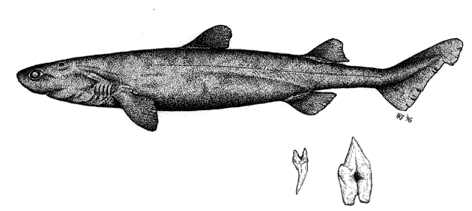Kitefin Shark (Dalatias licha)

(Bonnaterre, 1810).
| Fr: |
Squale liche |
| Sp: |
Carocho |
| It: |
Zagrino; Diavulu di funnu (Catania);
Paddottula (Messina); Neigra (Liguria); Zegrine
(Naples) |
| Ma: |
Murruna sewda |
Diagnosis
A moderately-sized, dark-coloured, cigar-shaped shark with a
short blunt snout and two spineless dorsal fins of similar size but
the second slightly larger; no anal fin; pelvic fins positioned just
anterior to the second dorsal. Pectoral fins short and rounded.
Ventral lobe of caudal fin very short; no caudal keels. Lips thick
and well-developed; upper teeth small and hooked; lower jaw-teeth
large and with serrated triangular cusps. Colour varies from black
to brownish-grey throughout, sometimes with with a blotchy
appearance although in most Mediterranean specimens seen by the
author the pigment is regular.
Size
Adult females to at least 160 cm; males to at least 120 cm;
commonly 90 cm to 120 cm.
Status and Distribution
Mediterranean Sea: Occasional or common; cosmopolitan
through the Western Mediterranean to the Ionian Sea (more so
to the West; Alboran and Catalon Seas; also Tyrrhenian Sea)
especially on the margins of deeper basins or offshore banks;
apparently absent or very scarce in the Adriatic, Aegean and zones
further eastwards.
Biology
A relatively common component of the Mediterranean's larger
deep-water elasmobranch fauna, the kitefin shark is epibenthic on
continental and insular shelves or slopes from about 40 to 1800 m
depth (primarily below 200 m) but will also occurs some distance off
the seabed. A powerful, heavy-jawed predator, this species
feeds primarily upon a wide spectrum of teleosts throughout the year
and occasionally elasmobranchs, including hake, lanternfishes,
gadids and even fast scombroids such as bonito; skates and small
sharks such as Etmopterus spinax, Squalus spp. and
Centrophorus spp. (particularly in the Winter and Spring);
also cephalopods (squid), crustaceans and annelid worms
(polychaetes). Crustaceans and small sharks become more
important in the diet with increasing maturity, whilst the
importance of cephalopods declines. Mediterranean data
indicates that this shark is solitary rather than schooling.
Ovoviviparous, with 10 to 16 young per litter; size at birth ca. 30
cm. Age at maturity currently unknown but males apparently
mature above 77 cm, females over 117 cm. Small specimens,
typically 40 to 50cm TL, are caught in Tunisian waters and
through the Sicilian Channel.
The Shark Trust, 36 Kingfisher Court, Hambridge
Road, Newbury, Berkshire,RG14 5SJ, UK.
Tel:(+44) 01635 551150 Fax:(+44) 01635
550230
|